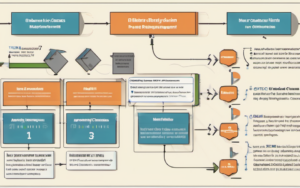The term “blockchain” has become synonymous with innovation and disruption, a technological force reshaping industries and changing the way we think about trust, security, and value. But how did this seemingly complex concept, often shrouded in technical jargon, rise from the fringes of the internet to become a mainstream phenomenon? The story of blockchain is one of radical ideas, passionate individuals, and a relentless pursuit of a decentralized future.
The Genesis of Blockchain: From Cypherpunks to the Digital Revolution
The seeds of blockchain were sown in the 1980s and 1990s, within the vibrant and often controversial “cypherpunk” movement. These digital activists, united by a deep distrust of centralized authority and a belief in the power of cryptography, envisioned a world where individuals could control their own data and interact with each other directly, without relying on intermediaries. While the cypherpunks’ ideas were largely theoretical, they laid the groundwork for the decentralized ethos that would later define blockchain technology.
The Cypherpunk Movement: A Seed of Decentralization
The cypherpunk movement, fueled by the growing internet and the rise of personal computers, focused on creating tools and technologies that would empower individuals and protect their privacy. They explored concepts like digital signatures, anonymous communication, and encrypted messaging, all of which would later become essential components of blockchain. While the cypherpunks themselves didn’t create blockchain, their vision of a decentralized world laid the foundation for the technology’s development.
Satoshi Nakamoto and the Birth of Bitcoin
In 2008, an enigmatic figure known as Satoshi Nakamoto published a whitepaper titled “Bitcoin: A Peer-to-Peer Electronic Cash System.” This document outlined a revolutionary concept: a decentralized digital currency that would operate without the need for banks or other financial institutions. The foundation of Bitcoin was a novel technology called blockchain, a distributed ledger system that recorded transactions in a secure and transparent manner.
Early Adoption and the Rise of Cryptocurrencies
Bitcoin’s launch in 2009 marked the beginning of a new era in finance and technology. Early adopters, driven by curiosity and a desire for financial independence, embraced the concept of a decentralized currency. The value of Bitcoin surged, attracting attention from mainstream media and investors. This early success spawned a wave of other cryptocurrencies, each with unique features and functionalities, further solidifying blockchain’s position as a transformative force.
Beyond Bitcoin: The Expanding Landscape of Blockchain Technology
While Bitcoin remains the most well-known application of blockchain technology, its potential extends far beyond digital currencies. Blockchain’s core principles of decentralization, transparency, and immutability have opened up a vast array of possibilities for various industries.
Smart Contracts: Automating Trust and Efficiency
Smart contracts are self-executing agreements written in code and stored on a blockchain. They automate the execution of contractual obligations, eliminating the need for intermediaries and ensuring transparency and trust. For example, a smart contract could automate a supply chain, ensuring that goods are delivered on time and that payments are processed securely.
Decentralized Finance (DeFi): Reimagining Financial Systems
Decentralized Finance (DeFi) leverages blockchain technology to create new financial services, removing the need for traditional intermediaries like banks and brokers. DeFi applications include lending platforms, decentralized exchanges, and stablecoins, enabling users to access financial services directly and securely. The potential of DeFi lies in its ability to democratize access to finance, reduce costs, and promote financial inclusion.
Non-Fungible Tokens (NFTs): Digital Ownership and Collectibles
Non-fungible tokens (NFTs) are unique digital assets that represent ownership of a specific item, whether it’s a piece of digital art, a collectible, or even a virtual piece of land in a metaverse. NFTs leverage blockchain technology to track ownership and authenticity, creating a secure and transparent system for digital ownership. This has led to a surge in interest in NFTs, particularly in the art and gaming industries.
Blockchain’s Impact on Industries: Transforming the World
The impact of blockchain extends far beyond the realm of finance, with its potential to revolutionize various industries by enhancing transparency, security, and efficiency.
Supply Chain Management: Transparency and Traceability
Blockchain can revolutionize supply chain management by providing a transparent and immutable record of goods’ movement from origin to destination. This enables businesses to track products, verify their authenticity, and ensure compliance with regulations. For example, a blockchain-based system could track the origin of food products, ensuring consumer safety and preventing fraud.
Healthcare: Secure Data Sharing and Patient Empowerment
Blockchain can address healthcare’s long-standing challenges of data security and patient privacy. By storing patient medical records securely on a distributed ledger, blockchain enables authorized individuals to access and share information while preserving patient confidentiality. This can improve patient outcomes by enabling better coordination among healthcare providers.
Government and Voting: Enhancing Security and Trust
Blockchain can enhance the security and transparency of government processes, including voting systems. A blockchain-based voting system would ensure the integrity of elections, making them more secure and resistant to fraud. It can also streamline government services, making them more efficient and accessible to citizens.
The Future of Blockchain: Challenges and Opportunities
Blockchain technology is still in its early stages, and its full potential remains to be realized. However, significant challenges need to be addressed to ensure its widespread adoption and impact.
Scalability and Sustainability: Addressing the Growing Demand
As blockchain adoption increases, so does the demand for scalability and efficiency. The current blockchain infrastructure needs to be optimized to handle a growing volume of transactions while minimizing energy consumption. This requires ongoing research and development to explore solutions like layer-2 scaling, sharding, and more efficient consensus mechanisms.
Regulation and Governance: Balancing Innovation and Security
The decentralized nature of blockchain technology presents challenges for regulation and governance. Governments and regulatory bodies need to develop clear frameworks for governing blockchain-based activities, balancing the need for innovation with the need to protect consumers and prevent financial crime.
The Potential for Social Impact: Empowering Communities and Individuals
Blockchain has the potential to empower communities and individuals by creating new opportunities for financial inclusion, social impact projects, and decentralized governance. For example, blockchain-based platforms can facilitate microloans to underserved communities, enabling entrepreneurship and economic development.
Blockchain’s Enduring Legacy
Blockchain technology is more than just a buzzword; it represents a fundamental shift in our understanding of trust, security, and value. Its decentralized nature empowers individuals and communities, fostering innovation and creating new opportunities. While challenges remain, the future of blockchain is bright, with the potential to reshape industries, improve lives, and create a more equitable and transparent world. As blockchain continues to evolve, it will undoubtedly continue to surprise and inspire, leaving an enduring legacy on the world we live in.




